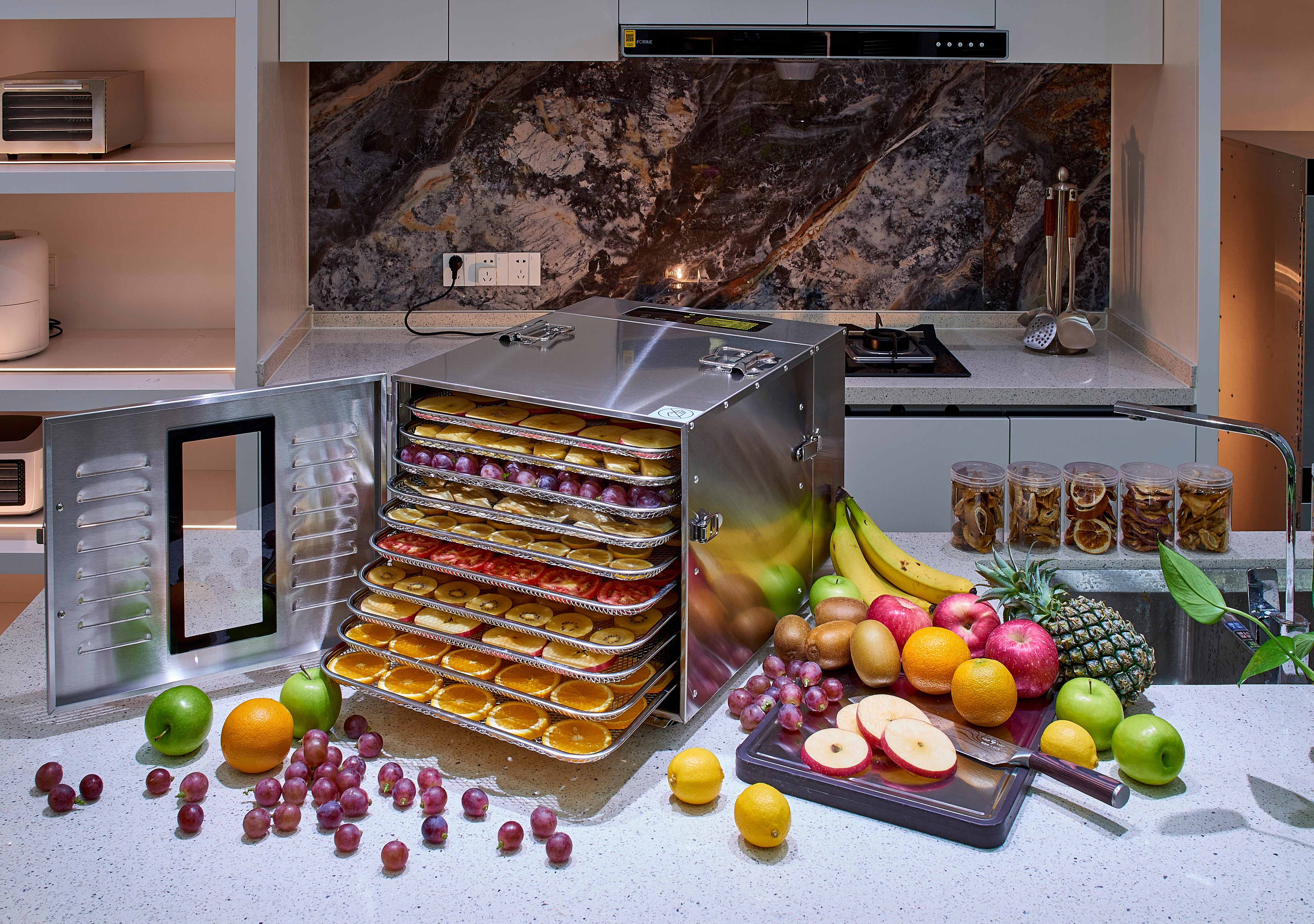INTRODUCTION
In the dynamic realm of culinary innovation, your choice of a food dehydrator transcends the ordinary—it's a pivotal decision that can shape the outcome of your gastronomic creations. In this exploration, we dive into the heart of the matter, dissecting the elemental showdown between plastic and stainless steel in food dehydrators.
Join us as we unravel the Pros and Cons, lifting the curtain on the advantages and drawbacks of Plastic Food Dehydrators, and delving into The Stainless Steel Advantage—why some enthusiasts passionately vouch for this material choice.
Are you ready to make an informed choice that aligns with your culinary aspirations? The answers lie within the nuances of material choices—let the dehydrator showdown begin.

Advantages and disadvantages of plastic and stainless steel in food dehydrators
Most plastic food dryers on the market today are made from modern plastics used for food contact surfaces and are usually BPA-free. Non-food contact parts are made from food-safe polycarbonate. It is not harmful to the human body. And plastic dryers are obviously more affordable. However, the durability of plastic can be an issue, especially with frequent use and exposure to varying temperatures.
Many stackable vertical airflow dehydrators on the market are made of plastic, such as square, rectangular or even oval shapes. This is due to the malleable nature of the plastic material, making it possible to produce appliances in a wide range of shapes. For example, the well-known brands NESCO, Presto, Waring Pro, and Excalibur, all of which have plastic food dehydrators.
Plastic is used in stackable vertical airflow food dehydrators such as the Waring Pro DHR30 and Presto 06301 as well as cabinet style horizontal airflow food dehydrators such as the Tribest Sedona Express and Excalibur 3948CDB.

On the other hand, stainless steel stands as a symbol of durability and robustness in the culinary world. Renowned for its resistance to corrosion and wear, stainless steel is the preferred choice for those seeking longevity and reliability in their kitchen appliances. Stainless steel food dehydrators are all cabinet shaped. For example, Septree's 10-Tray Food Dehydrator. Although stainless steel dehydrators are more expensive than plastic dehydrators, they are superior in performance. Stainless steel can withstand high temperatures for a long time, the trays are not easily deformed and are more durable.

10 Stainless Steel Trays Countertop

10 Trays Food Dehydrator Stainless Steel Dryer Machine
I personally feel that stainless steel trays are also easier to clean than plastic trays, are less prone to grease and are usually dishwasher safe. Not only that, but they are also more efficient. Since they are made of stainless steel, they can withstand extremely high temperatures without any risk of damage.
Compared to dehydrators made of stainless steel, those made of plastic are more likely to get dirty. When buying a plastic dehydrator, you need to consider: plastic trays can sometimes be deformed by excessive temperatures, or poor quality ones can even melt.

How Material Influences the Efficiency of Food Dehydrators
Efficiency in a food dehydrator translates to consistent and optimal results in preserving the texture, flavor, and nutritional content of the ingredients. One of the primary considerations is the heat conductivity of the material. Stainless steel, known for its excellent heat conductivity, ensures uniform distribution of heat across the trays. This even distribution minimizes the need for constant monitoring and tray rotation, resulting in a more hands-free and efficient dehydration process.

Conversely, plastic, while being a reliable insulator, may not offer the same level of heat conductivity as stainless steel. This can lead to potential variations in temperature across trays, requiring users to be vigilant and rotate trays periodically for uniform drying. While this doesn't necessarily diminish the quality of the dehydrated food, it may demand more hands-on attention during the dehydration process.
Another critical factor is the insulation properties of the material. Plastic, being an insulator, helps in retaining heat within the dehydrator. This can contribute to energy efficiency, making plastic dehydrators more economical to operate over extended periods. However, it's essential to strike a balance, as excessive insulation might lead to longer dehydration times.
CONCLUSION
In the realm of culinary exploration, the choice between a plastic and stainless steel dehydrator emerges as a defining decision, each with its unique set of advantages and considerations. As we navigate the intricacies of these materials, it becomes evident that the ideal dehydrator aligns with individual preferences, culinary needs, and lifestyle. Whether you opt for the lightweight and cost-effective nature of a plastic dehydrator or the robust construction and superior heat conductivity of stainless steel, the key lies in making an informed decision that complements your culinary aspirations. Whichever path you choose, may your dehydrating journey be filled with flavors, textures, and the satisfaction of a choice well-made.

If you need more info about food dehydrator, just look around on our store! Click here to learn more about Septree Food Dehydrators!

